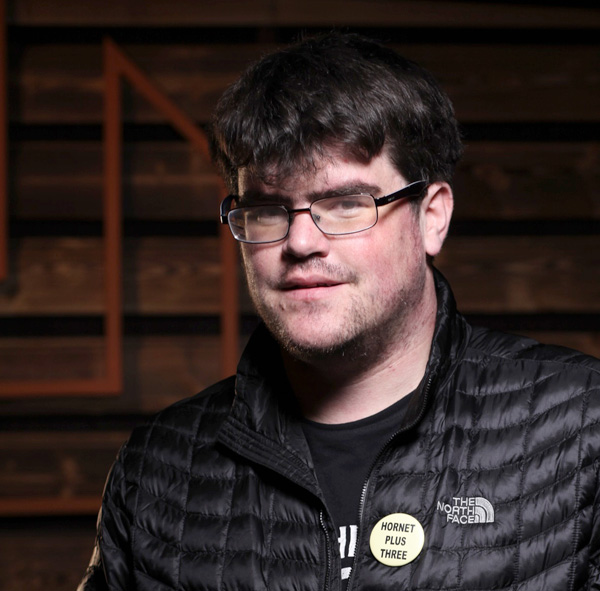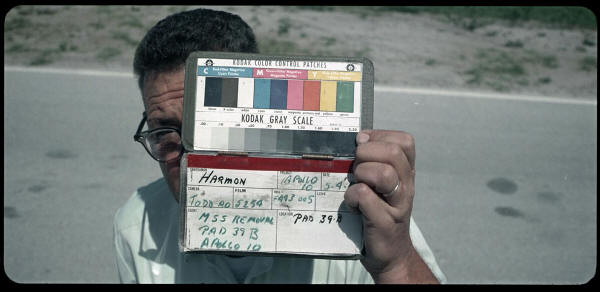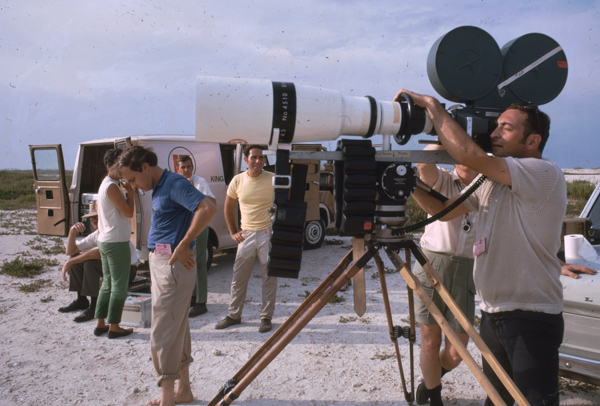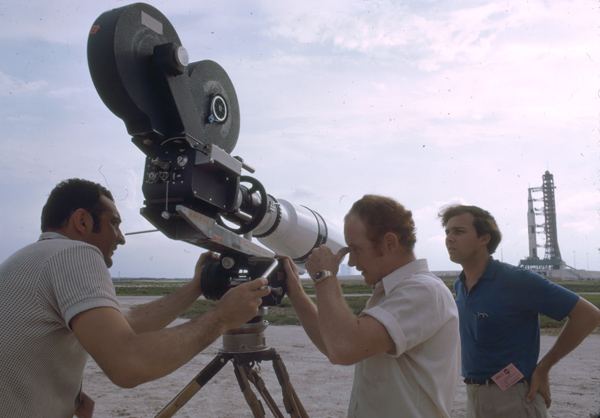Stephen Slater in Conversation |
Read more at in70mm.com The 70mm Newsletter |
| Interviewed by: Thomas Hauerslev in Bradford 14. October 2019. Transcribed for in70mm.com by Mette Petersen. | Date: 17.05.2020 |
 Stephen
Slater headed up the archive research and production for "Apollo 11", an new
"all archival" documentary about the Apollo 11 mission, which premiered at
the 2019 Sundance Film Festival. The film contained never before seen 70mm
film archive of the mission, scanned especially for the project. It became
the highest grossing documentary of 2019, and was nominated for a BAFTA in
2020 for Best Documentary. Stephen
Slater headed up the archive research and production for "Apollo 11", an new
"all archival" documentary about the Apollo 11 mission, which premiered at
the 2019 Sundance Film Festival. The film contained never before seen 70mm
film archive of the mission, scanned especially for the project. It became
the highest grossing documentary of 2019, and was nominated for a BAFTA in
2020 for Best Documentary.Thomas Hauerslev: Stephen Slater, please tell me about your responsibility on "Apollo 11", the latest film on the Apollo missions? Stephen Slater: I am the archive producer for the "Apollo 11". THa: What does that job imply? Stephen: In layman's terms it means that I am in charge of all the archive research and production for the film, and given that I have a longstanding expertise in NASA film archive, it was my idea to do the film to coincide with the Apollo 11 50th anniversary. THa: How did the project first get off the ground? Stephen: It began with a documentary short we made called "The Last Steps", also funded by CNN. In early 2016 the director Todd Douglas Miller approached me to work on a film about Apollo 17, which was the last moon landing in 1972. The idea was to make a very similar style film to what we eventually deployed with "Apollo 11", in other words "all archival", no interviews and no narration. It was largely based on a significant tranche of footage that I had acquired over the years related to Apollo 17, and so I handed that over to him, and from that they sculpted this really lovely 30 minutes short film. THa: I have seen it on YouTube Stephen: Yes, I really love it, particularly the music by my friend Matt Morton. That film actually premiered three years ago last week at the Hamptons International Film Festival (in the pre Trump era!). Anyway... because I had also already done significant work with the Apollo 11 mission archive, I then proposed that we make a similar film in time for the 50th anniversary, which at the time was nearly three years away. At this stage I primarily had the 16mm archive shot in mission control during the mission which had all been shot completely mute (MOS). There was no sound on any of this stuff, and I'd had this kind of crazy side project where I'd listened through the flight loops and manually lip-synced it to the sound-less footage, so it started with an idea about how we could potentially use that material to create a new film. |
More in 70mm reading: Gallery: Apollo program photographed in Todd-AO by NASA as seen in "Apollo 11" "Apollo 11" Official press release “APOLLO 11: FIRST STEPS EDITION” Portrait of Mitchell's Todd-AO 65mm Camera AP-65 Internet link: stockfootagenewsroom.com Todd Douglas Miller, Director SMPTE 2019: Apollo 11 - Restoring a Masterpiece Crafting the Score of "Apollo 11" with Matt Morton "Moonwalk One" WiKi "Moonwalk One" "The Last Steps" by Todd Douglas Miller Apollo 11 movie Vanity Fair Article |
 Todd-AO
65mm frame with a slate. Cameraman: Harmon. Camera: Todd-AO.
Location: Pad 39B. May 1969. From Todd Douglas Miller's PPT presentation. Todd-AO
65mm frame with a slate. Cameraman: Harmon. Camera: Todd-AO.
Location: Pad 39B. May 1969. From Todd Douglas Miller's PPT presentation.Click to see enlargement. THa: How did the 70mm or the 65mm footage show up? How did you discover that? Stephen: When we decided to go ahead with the film it was very important, certainly in Todd's mind, that this was going to be a "big screen experience". I know that IMAX distribution was in his mind from the start, and to pull that off we obviously knew that we would need to track down all the source film material from Apollo 11, and to have all the original reels scanned, because it is no good working from duplicate copies if you're looking to achieve high quality cinema projection. We'd been doing research at the National Archives in Maryland, which is the end repository for all the films shot by the U.S government. On May 10th 2017 we received a progress report from Dan Rooney, the supervisor archivist there, and in that email was a bullet point, saying that they had found 165 reels of 65mm reels. They weren't 100% sure of what was on them, but about a third of them were directly related to Apollo 11. That was a historic moment. |
|
|
Click to see enlargement. THa: What other Apollo missions did the reels cover? Stephen: The collection actually spanned from the Gemini programme (1966) all the way through to shortly before Apollo 13 in early 1970. They shot more of the Apollo 11 mission than anything else (for obvious reasons), and I think to a certain extent some of the earlier material was shot as a "rehearsal" for 11, which I suppose is rather like the missions themselves, in that they were all building towards achieving the moon landing goal. THa: How did you physically examine the cans to find what you needed? How did that work? Stephen: Well the first problem was that there was no scanner that was capable of handling this stuff, or rather, the scanners that existed were so cumbersome that it would have taken years to process it all. In any case though, the National Archives won't just send that anywhere, we had to make a partnership agreement with them. It was all eventually agreed that it would be done in New York, and the reels had to be transported there in climate-controlled vans. For the actual scanning Final Frame, our Post production facility actually designed a special scanner that could deal with the 70mm reels at resolutions of up to 16k. What made the scanner unique is that it didn't need any pin registration, and it still doesn't. It still exists and it is a hot property at the moment [laughs]. The film negative doesn't physically need to touch the scanner, and it essentially rides on a bed of air, but I'm no technical expert when it comes to this stuff... it's definitely worth speaking to them about it! |
|
 Todd-AO's
AP65 65mm camera with a long focal length lens photographing the Apollo program.
NASA Production still curtsy Stephen
Slater Todd-AO's
AP65 65mm camera with a long focal length lens photographing the Apollo program.
NASA Production still curtsy Stephen
SlaterTHa: Were there any kind of labels, like "Todd-AO" or "Panavision", on the 65mm cans? Stephen: I didn't physically look at a lot of the cans myself. What I had access to was mainly all the shot-lists which allowed us to plan how we would attack the scanning effort. The footage was actually very well described and catalogued, so we knew early on what kind of material we would likely be dealing with. I don't think we quite realised how good it was though until we saw the images [laughs]. THa: Did you scan all the 65mm material? Stephen: Yes, most of that was known as the "Panavision Collection". We also went to the Marshall Space Flight Centre in Alabama, where NASA built all of the Saturn V rockets. They had all this 10 perf engineering 70mm footage that had been used to document the launches in great detail, and that was a real challenge to scan. A very "non-standard" format. THa: You had around 165 cans with 65mm negative, how did you decide what material to use? Stephen: Well, the fundamental backbone of the film was that we needed to tell the story of the Apollo 11 flight "as it happened", therefore anything that was shot during the 8/9 days of the mission was the priority. Astronaut training and non "mission-specific" material such as the post flight celebration tour was less of a priority. |
|
 "The
way we discovered the 65mm, and seeing it for the first time was something that
I will never forget. There was two reels, and we put them on a prototype scanner
that the guys at Final Frame had built, and you would just see these little
bursts of imagery about every three of four seconds" - Todd Douglas Miller,
Director "The
way we discovered the 65mm, and seeing it for the first time was something that
I will never forget. There was two reels, and we put them on a prototype scanner
that the guys at Final Frame had built, and you would just see these little
bursts of imagery about every three of four seconds" - Todd Douglas Miller,
DirectorTHa: When you saw the scanned materials for the first time on the screen, what was your reaction to it? Stephen: We initially decided to prioritise a select number of reels to do some scanning tests with. So I looked at the shot-lists and selected the suiting up footage of the astronauts from the day of the launch, shots of the crawler moving the Saturn V rocket to the launch pad, and the Apollo 11 launch itself. They went away and scanned this, and I know that the team's jaws were on the floor in the scanning room. Then we all went out to Washington D.C, to the Air and Space museum IMAX theatre, which is where we got to see it on the giant screen for the first time. That was in December 2017 and a day I will never forget [smiles]. • Go to Gallery: Apollo program photographed in Todd-AO by NASA as seen in "Apollo 11" THa: What was the reaction between you and your colleagues seeing the first scanned images? Stephen: It was amazing. I know that the first shot that our team saw was the aerial shot of the crawler, on the way to the pad flipped upside down. Actually, Todd describes it here [shows YouTube clip]:
|
|
Appendix - "Moonwalk One" in 65mm
|
|
 Todd-AO's
AP65 65mm camera with a long focal length lens photographing the Apollo program.
NASA Production still curtsy Stephen
Slater Todd-AO's
AP65 65mm camera with a long focal length lens photographing the Apollo program.
NASA Production still curtsy Stephen
Slater"NASA had originally wanted MOONWALK done in 70mm (under the impression that 70mm was somehow "better" than 35) and Kamecke covered the launch himself with three 70mm crews. He soon realized, however, that to hope to do the entire film in 70mm was unrealistic. Film stock was extremely expensive; the lenses were slow; the cameras unwieldy; and the cost and limitations of 70mm in no way meshed with NASA's modest budget. Kamecke was thus able to persuade them to switch to 35mm. However, NASA itself had used 70mm in some of the cameras covering the launch (considering it only proper that part of the moon-shot be filmed in wide-screen panoramic splendor) and this 70mm footage then had to be reduced in order to be included in MOONWALK. Unfortunately, the stock used had been a special 70mm developed by Kodak for the Air Force. The film had a high, square frame and ten sprockets which caused a considerable and expensive reduction problem. And of course, in every instance, Kamecke had to decide which portion of the frame would be reduced. Then prints had to be made of the footage unearthed in Huntsville. And special quality prints were needed of the 16mm footage which the astronauts had shot. All this managed to burn up a large portion of the budget. But most of MOONWALK (only one-third of it is NASA footage) was shot in true low-budget fashion with a minimal crew consisting of Kamecke, a cameraman, and one assistant." |
|
| Go: back - top - back issues - news index Updated 22-01-25 |
